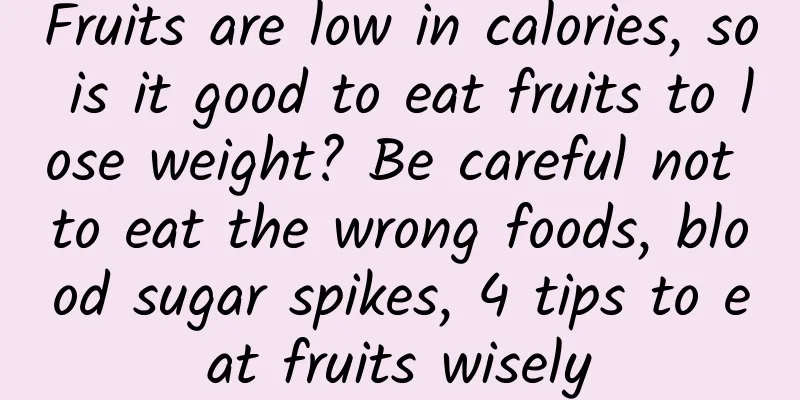Fruits are low in calories, so is it good to eat fruits to lose weight? Be careful not to eat the wrong foods, blood sugar spikes, 4 tips to eat fruits wisely

|
Many people believe that fruits have no fat, no starch, and are rich in fiber. In fact, most fruits are low in calories. Therefore, whether people want to lose weight or control blood sugar, they will often replace meals with fish and meat with fruits. However, there have been several cases recently where people who wanted to lose weight replaced their three meals with fruits. They ended up eating so much that they became weak and had to seek emergency medical treatment. After examination, they were found to have diabetes. Mackay Memorial Hospital nutritionist Xu Bihui said that diabetes is a disease of civilization for modern people. When the blood sugar level in the body remains in an abnormal range, causing metabolic problems, the body will experience three more reactions: "drinking more, eating more, and urinating more." The diabetes commonly mentioned mostly belongs to type 2 diabetes, which is mainly caused by metabolic syndrome due to obesity. Currently, more than 90% of diabetes cases are type 2 diabetes, and a small number are type 1 diabetes (congenital autoimmune disease) and gestational diabetes. So why is eating healthy and high-fiber fresh fruits related to diabetes? Fruits are high in sugar, and eating too much can cause metabolic problemsAfter the improvement of agricultural technology in Taiwan, almost every kind of fruit is sweet. Pineapples, watermelons, mangoes, etc., which are abundant in summer, are all sweet and fragrant. In the eyes of nutritionists, the sugar content in fruits is really not low. Therefore, if you eat high-sugar fruits with three meals a day, although you can eat a lot of fiber and nutrients, you will also consume a lot of sugar. After Taiwan's agricultural technology was improved, almost every fruit is sweet. In summer, pineapples, watermelons, mangoes, etc. are abundant, and each one is sweet and fragrant. If you eat like this for a long time, your sugar intake will definitely exceed the limit. Even if you have no family history of the disease and no risk factors such as obesity, heart disease, high blood pressure, high blood lipids or polycystic ovary syndrome, unhealthy eating habits and long-term intake of high-sugar foods in the diet can easily cause metabolic problems in the body, which can lead to diabetes over time. Healthy adults: 2 servings of fruit a day, diabetics: 1 serving of fruit a dayNutritionist Chen Yunfan reminds us that we don’t have to worry about our blood sugar levels going through the roof after eating fruits that are too sweet. Instead, we should have a concept of the total sugar content in our diet. We should learn how to add up the total amount of sugar we should eat in a whole day, including the sugars contained in natural foods (starches such as rice, bread, noodles, etc.), glucose, fructose, lactose, etc. Regardless of whether you are a diabetic or someone with high blood sugar levels, you can actually eat any kind of fruit. The key is to strictly limit the amount of fruit you eat. Generally speaking, it is sufficient for a healthy adult to eat 2 servings of fruit a day, while it is sufficient for a diabetic patient to eat only 1 serving. So how much is 1 serving of fruit? Taking the most commonly eaten apple as an example, it is about half an apple or 16 cherry tomatoes. Regardless of whether you are a diabetic or someone with high blood sugar levels, you can actually eat any kind of fruit. The key is to strictly limit the amount of fruit you eat. But don't forget that fruits also have calories, and the sweeter the fruit, the higher the calories it usually contains. This is because among the three major nutrients, fruits do not contain fat and protein. Therefore, the sugar content of fruits is the main factor affecting the amount of calories. In addition, some people think that fruits with high water content will have lower calories. However, nutritionists say that there is no correlation between the two. Therefore, fruits with high water content, such as watermelon, will not have lower calories. This is something you need to pay special attention to. Because there is no sweetness meter for accurate measurement, it is difficult for ordinary people to know the actual sugar content of fruit. Therefore, when eating fruits that taste sweet, especially diabetic patients or patients with chronic diseases, they should remind themselves to be more moderate in their portion intake so as not to consume excess sugar. Choose low GI fruits, blood sugar rises more slowlyIn addition to controlling the amount of fruit you eat, people with diabetes or high blood sugar levels are usually advised to choose fruits with lower GI values when they want to eat fruit, as a reference for their eating priorities. The so-called low GI diet theory means that after eating foods with low GI values, blood sugar will not rise rapidly, insulin will not rush to store the excessively high blood sugar as fat, and you will not get fat. Common low GI fruits include apples, bananas, grapefruit, dragon fruit, cherry tomatoes, pears, cherries, kiwis, etc., which are all fruits rich in fiber. It is worth noting that many diabetic patients often think that guava is less sweet and is very suitable for diabetic patients, but they eat a whole one every time. Xu Bihui said that in fact, the sugar content of guava is also very high. One guava contains about 3 tablespoons of sugar. If a diabetic patient eats one guava at a time, it has already exceeded the total fruit intake in a day. No wonder blood sugar will soar quickly. 【4 tips for eating fruit wisely】Tip 1: Eat 2 servings of fruit a day: The amount of fruit a healthy adult should eat in a day is about the size of two girls' fists. However, girls' fists vary in size. Therefore, it is recommended that you take out a regular-sized bowl, cut the melon and fruit into pieces and put them in the bowl. One flat bowl counts as one serving, and you can eat two servings of fruit in a day. Tip 2: Don’t eat all of them at one meal: It is recommended to eat fruits in separate meals instead of eating all the fruits in one meal, because the sugar content of 1 serving of fruit is equivalent to 1 tablespoon of sugar. You cannot eat 2 servings of fruit a day in the same meal or at the same time, otherwise your body's blood sugar will rise too much after the meal. The best way to eat it is to separate the two portions of fruit and eat them after breakfast and lunch. Tip 3: Eat during the day and use it effectively throughout the day: It is recommended to eat fruits during the day, because most of the energy used in a day is used during the day, just like it is recommended to take vitamins during the day, so that nutrients can be used throughout the day and blood sugar can be kept stable. Tip 4: Eat as a snack between meals: Diabetic patients can eat fruit as a snack between main meals. For example, if they feel hungry between breakfast and lunch, and their blood sugar level is low, they can take out the portion of fruit they plan to eat after lunch as a snack. At this time, the body can satisfy hunger by eating fruits, and increase the amount of sugar entering the body, which can slightly increase the blood sugar concentration under the original hungry state; when you eat lunch at 12 o'clock, you will not overeat because you have been hungry for too long, and eat too much food by chewing in big mouthfuls. Another portion of fruit can be eaten as a snack during afternoon tea before dinner, which can also avoid eating too much at dinner and increase the burden on the body. Fruit juice is most likely to contain excessive amounts of sugar Since you can’t eat too much fruit, generally adults can eat 2 servings a day, and diabetics can only eat 1 serving a day, then add ice cubes to the fruit and make it into a fresh juice smoothie. It is refreshing and healthy, and is always better than drinking other beverages. But from a nutritionist’s point of view, this whole cup is full of sugar that exceeds the serving size! Xu Bihui said that the amount of fruit recommended for diabetic patients is indeed not much, and it is a bit difficult to make a cup of juice with this amount of fruit. Therefore, they will unknowingly add a lot of fruit or mix it with Yakult, milk, sugar water and other beverages. In this way, the sugar content of a glass of juice will be off the charts. The amount of fruit recommended for diabetic patients is indeed not much, and it is a bit difficult to make a cup of juice with this amount of fruit. Therefore, you will unknowingly add a lot of fruit or mix it with Yakult, milk, sugar water and other beverages. After drinking a glass of juice, the sugar content will be off the charts. If you still want to drink fruit juice, there are two important points to note. The first is not to remove the pulp, but to retain the fiber in the fruit and drink it with the pulp. The second is to control the amount. Take the most common orange juice as an example. One cup of freshly squeezed orange juice on the market is about 350cc. On average, one orange can only produce about 70cc of juice. In other words, at least five oranges are needed to make one cup of orange juice. The sugar content of one cup of orange juice is equal to five tablespoons of sugar. The body absorbs so much sugar instantly. No wonder blood sugar becomes unstable. Therefore, it is recommended to eat fresh solid fruits. How do you know if you have diabetes? Most people with diabetes have no symptoms in the early stages. To know whether you have diabetes, you need to have a blood test. The normal blood sugar level for a person with diabetes is 70-100 mg/100 ml after 8 hours of fasting. If it is higher than 126 mg/100 ml, you have diabetes. Or you can do a glucose tolerance test by drinking 75 grams of glucose water. If the blood sugar level exceeds 200 mg/100 ml after 2 hours, or if you have symptoms of high blood sugar and your blood sugar level exceeds 200 mg/100 ml at any time, you have diabetes. 1 serving of fruit
Can dried fruit replace fresh fruit? During the manufacturing process of air-dried or pickled fruits, the nutrients in the fruits will be destroyed due to light and heat. For example, the phytochemicals in the fruits will be reduced when exposed to light and heat. In addition, the air-dried fruits become smaller in size, making it easy to eat too much without realizing it. Taking fresh grapes and raisins as examples, 10 grapes and 10 raisins are both 1 serving of fruit. However, after eating 10 grapes, you will feel a little full because of the water content. However, after eating 10 raisins, you often cannot stop. You may grab a handful of 20 and put them into your mouth one handful at a time. In addition, the dried fruits will be added with seasonings such as plum powder or icing sugar, so the sugar content has already exceeded the daily requirement. Therefore, it is not recommended to replace fresh fruits with dried fruits. [Source: Changchun Monthly Issue 401] |
Recommend
What are the most important things to pay attention to in painless abortion?
Painless abortion is a common operation to termin...
Prevention of cervical precancerous lesions in daily life
Now many female friends are troubled by a disease...
How to regulate blood clots during menstruation? Four methods are recommended
During menstruation, most people's menstruati...
Is vomiting normal after miscarriage?
Generally speaking, artificial abortion refers to...
What are the general tests for diagnosing functional uterine bleeding?
The general examinations for the diagnosis of fun...
Can I eat longan after abortion?
You can eat longan in moderation after abortion, ...
How many methods are there for abortion? There are 4 treatments
In clinical treatment, there are many methods tha...
Is Oolong Tea the Best for Fat Removal and Weight Loss? Nutritionist: Do less of these things to avoid affecting your weight loss results
Many people are accustomed to drinking a cup of t...
Recipes for adnexitis
Adnexitis is a common and relatively serious gyne...
How to treat female cervical hypertrophy? Does cervical hypertrophy need treatment?
How to treat cervical hypertrophy in women? Exper...
What are the early symptoms of vulvar leukoplakia that you know?
What early symptoms of vulvar leukoplakia do you ...
Precautions and maintenance methods before and after abortion surgery
Abortion is the act of terminating a pregnancy be...
What are the hazards of severe cervicitis in women? What causes severe cervicitis in women?
Severe cervicitis can cause infertility and other...
What are the causes of adenomyosis?
As a common gynecological disease, although adeno...
Enjoy the authentic flavor! Eat this way to burn fat and lose weight easily
Preparing diet food requires blanching or removin...









